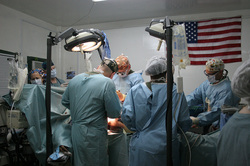
Breast Cancer is detected, Now What? My Treatment options?
Following a clinical examination a Biopsy is the only definite way of confirming or ruling out breast cancer in suspected cases. A piece of breast tissue is taken for testing; this can be done by inserting a needle into the Breast (FNAC-fine needle aspiration cytology), or by an operation under local or general anesthesia. A pathologist then examines the breast tissue under the microscope to check for cancer cells.
Surgery, chemotherapy and radiotherapy are the three options available for treating breast cancer. Often the treatment given may be a combination of 2 modalities, such as surgery followed by radiotherapy; or chemotherapy followed by surgery. Selection of the appropriate therapeutic approach depends on the location and size of the tumor, breast size, appearance on the mammogram, the extent of change in the tissues, and the preference of the patient and treating doctor.
Surgery: is the commonest modality of cancer treatment wherein the surgeon removes the affected tissues mostly a localized tumor. The types of surgery may vary. Mastectomy means total removal of breast tissue.
Radiotherapy: involves subjecting the tumor-bearing region either in part or whole to ionizing radiation using a variety of delivering systems.
Chemotherapy: involves using cytotoxic drugs capable of arresting fast growth of cancer cells.
It is highly advised that the patient understands all the treatment options completely. The journey is extremely tough but recovery is the destination.
Following a clinical examination a Biopsy is the only definite way of confirming or ruling out breast cancer in suspected cases. A piece of breast tissue is taken for testing; this can be done by inserting a needle into the Breast (FNAC-fine needle aspiration cytology), or by an operation under local or general anesthesia. A pathologist then examines the breast tissue under the microscope to check for cancer cells.
Surgery, chemotherapy and radiotherapy are the three options available for treating breast cancer. Often the treatment given may be a combination of 2 modalities, such as surgery followed by radiotherapy; or chemotherapy followed by surgery. Selection of the appropriate therapeutic approach depends on the location and size of the tumor, breast size, appearance on the mammogram, the extent of change in the tissues, and the preference of the patient and treating doctor.
Surgery: is the commonest modality of cancer treatment wherein the surgeon removes the affected tissues mostly a localized tumor. The types of surgery may vary. Mastectomy means total removal of breast tissue.
Radiotherapy: involves subjecting the tumor-bearing region either in part or whole to ionizing radiation using a variety of delivering systems.
Chemotherapy: involves using cytotoxic drugs capable of arresting fast growth of cancer cells.
It is highly advised that the patient understands all the treatment options completely. The journey is extremely tough but recovery is the destination.
SABCA Foundation, a fiscally sponsored project of United Charitable Programs - a registered 501(c)(3) public charity
